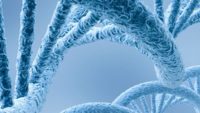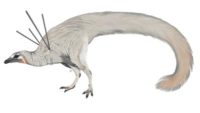Interview with Dr Brian Thomas, expert in collagen in fossil ‘millions of years old’ …read more Source: creation.com
By Dr. Georgia Purdom All our lives, we’ve heard that our physical makeup is determined by our genes, not environment. But the science of epigenetics is forcing scientists to rethink their assumptions. …read more Source: AIG Daily
There are two types of nucleic acids (genetic molecules): DNA and RNA. DNA (deoxyribonucleic acid) is a large linear molecule designed to store genetic information in all cells. RNA (ribonucleic acid) serves as a blueprint for proteins and occurs in three forms: transfer-RNA, ribosomal RNA, and messenger-RNA. It has been said that nucleic acids are like an onion. As biologists peel away a layer of complexity, underneath lies anothe… More… …read more Source: icr.org
More evidence that fossils are better explained in the biblical timeframe …read more Source: creation.com
How in the world did a creature as odd as the duck-billed platypus originate? This creature lays eggs like a reptile, has venom like a reptile, spurs like a chicken, excretes milk from belly patches to nurse its young, has fur that glows, webbed feet like a duck, and uses its sensor-filled duck-like bill to find aquatic prey like paddlefish do since it swims with its eyes closed. If it evolved, then did its ancestors include mammals, reptiles, bi… More… …read more Source: icr.org
Are they useless evolutionary relics, or important part of design? …read more Source: creation.com
By Dr. Elizabeth Mitchell Evolutionists trying to explain what causes convolutions to form in a human fetus suggest how the human brain evolved from apelike ancestors. …read more Source: AIG Daily
Amazingly and uniquely designed by God …read more Source: creation.com
What does the ear’s design show about the Creator? …read more Source: creation.com
All plant and animal genomes studied so far exhibit complex and distinct three-dimensional (3-D) structures in their chromosome configurations depending on the type of cell (e.g., heart, liver, brain, etc.). Given the incredible variability among genome configurations within a single type of creature, let alone that which exists between creatures (e.g., human vs. chimpanzee), this area of evolutionary comparison has been difficult for secular res… More… …read more Source: icr.org
Creationists have long speculated about the earth’s environment prior to the global Flood—conditions which may have contributed to the long human life spans recorded in the Biblical record of Genesis. Specifically, it has been hypothesized by some that the pre-Flood earth atmosphere had higher levels of oxygen and a greater atmospheric pressure than we currently observe. Now, a new study from Tel Aviv University and the Shamir Medical… More… …read more Source: icr.org
By Dr. Alan L. Gillen Shortly after Darwin published On the Origin of Species, Pasteur began to challenge the idea of spontaneous generation. …read more Source: AIG Daily
Does pregnant ‘Mary’, a stickleback fish from the Outer Hebrides, support evolution? …read more Source: creation.com
By Ken Ham To say a new “dinosaur” being described by news media as “unusual” would be an understatement! This new “dinosaur,” Ubirajara jubatus, is described as having “a long mane of fur [really, structures that might have been feathers] down its back and stiff [nearly 6-inch] rod-like structures projecting from its shoulders.” It’s “totally weird,” one researcher says. So what is it really? Well, our paleontologist Dr. Gabriela Haynes read the original scientific paper, and here’s what she had to say about this crazy-sounding creature: It is important to understand the way that evolutionist researchers name and group animals [More]
Two separate spider research projects published remarkable results, both in the journal Current Biology. These spiders’ specific features show their miniature skills, and cause us to marvel at their Maker. Andrew Gordus is a neurobiologist and was the senior author of a recent spider web study. He told Johns Hopkins University, “After seeing a spectacular web, I thought, ‘if you went to a zoo and saw a chim… More… …read more Source: icr.org
By Lisa Smetak God designed some amazing glow-in-the-dark creatures that make their own light. …read more Source: AIG Daily
Rock layers in China have yielded yet another strange bird. Two features in its partial skull—the only parts found—make it both a unique discovery and a challenge to nature-only origins stories. First, its beak is long and curved like a modern hornbill. That’s a first among the many birds trapped in Cretaceous rock layers alongside fishes, dinosaurs, and crocodilians. The research team published details of the fin… More… …read more Source: icr.org
Not only can plants ‘hear’, but they can respond rapidly. …read more Source: creation.com
By Heather Brinson Bruce The snow leopard survives in its frigid climate thanks to a collection of cool features. …read more Source: AIG Daily
Sever an arm from an octopus, and like an underwater zombie it’ll keep groping its surroundings. Even without a brain, its suckers still detect and grab crabs in lab experiments. Now Harvard researchers have begun discovering what makes octopus suckers so smart. The team led by molecular biologist Nicholas Bellono found special sensory cells on each sucker’s skin surface.1 One type of sensor houses mechanorec… More… …read more Source: icr.org
God’s creative power on display …read more Source: creation.com
Dogs don’t read the words on a page. Neither did Coco, the famous gorilla that learned to communicate using simple hand signs. So what affords humans the unique ability to read and write, and why do we do it? These kinds of questions drive Zeynep Saygin’s research at Ohio State. Her team’s recent discovery sets the stage for some answers. Brain experts already knew about the visual cortex—an area of the brai… More… …read more Source: icr.org
How do chemicals “decide” to become alive? That they can, and did, is essentially the basis for today’s widely accepted origin-of-life theory. But Rice University professor James Tour, a synthetic organic chemist who is widely considered one of America’s leading experts in nanotechnology and nanoengineering, says this theory is not only unproven but untenable. Moreover, he states that in private, many fellow scientists agree with him. Read More: Scientists Are “CLUELESS” About Origins of Life, Says Top Chemist and Nanotechnologist – The New American
By Ken Ham In a new study, scientists compared the visual system of a very tiny lemur from Madagascar, the mouse lemur, with that of other primates and found that “the size of these visual processing units is identical in all primates, independent of their body size” and that “the way the units are arranged across the brain was totally indistinguishable, following the same rules with mathematical precision . . . [and] the number of nerve cells per visual unit was almost identical.” Now why is this significant? Well, this is considered important in the evolutionary view because mouse lemurs [More]
Much to trophy-hunters’ disappointment, bighorn sheep on Ram Mountain are not what they were. But is it evolution? …read more Source: creation.com
Dr. Mark Armitage of the Dinosaur Soft Tissue Research Institute lectures on the latest research about dinosaur soft tissue and how this can be used for witnessing the Gospel. All the videos taken together constitute the lecture. Lots of great info and slides showing this tissue.
Does the evidence justify invoking this mechanism to preserve soft tissues for millions of years? …read more Source: creation.com














































